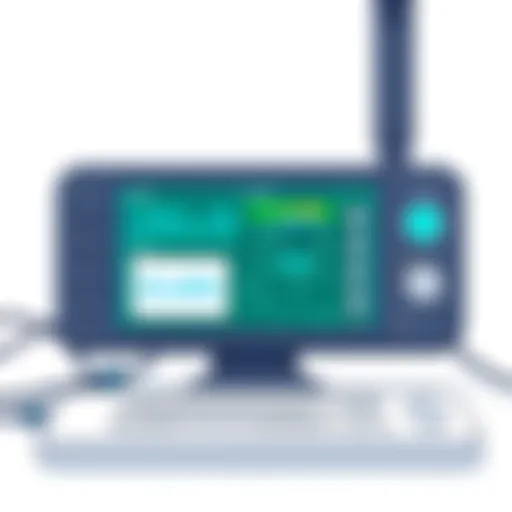Understanding Laserfiche: A Guide for Software Buyers


Intro
Laserfiche stands as a leader in the realm of enterprise content management (ECM) solutions. Its significance extends across numerous sectors, providing organizations with the tools needed for efficient document management. As the need for streamlined processes continues to grow, understanding Laserfiche becomes vital for software buyers seeking reliable solutions that can enhance productivity and collaboration.
This guide seeks to offer a detailed examination of Laserfiche, exploring its core features, pricing models, and target users. By dissecting the platform's functionalities and highlighting its advantages, industry advisers and IT professionals can make informed decisions based on the specific needs of their organizations.
The landscape of software buying can be intricate, hence the aim of this document is to illuminate the complexities surrounding Laserfiche. This will include comparisons with alternative ECM solutions and applicable best practices for implementation. In doing so, this guide will serve not just as an overview, but as a comprehensive tool for navigating the diverse software market.
Key Features and Functionalities
Comprehensive Overview
Laserfiche offers a wide array of features designed to streamline document management and improve operational workflows. At its core, the software excels in automation, effectively reducing manual tasks such as filing, searching, and retrieving documents. Key functionalities include:
- Document Capture: Laserfiche simplifies the process of capturing physical documents through scanning and automatic data extraction, making it easy to digitize information.
- Workflow Automation: Users can create custom workflows that reflect their unique processes. This feature minimizes bottlenecks and ensures tasks progress smoothly through defined stages.
- Collaboration Tools: The platform provides tools that enhance team collaboration. Users can comment on documents, assign tasks, and share information securely.
- Compliance Management: With regulatory requirements growing more stringent, Laserfiche incorporates compliance tracking. This helps organizations manage sensitive information while adhering to applicable regulations.
Target Users
The versatility of Laserfiche makes it suitable for a diverse range of sectors. Its primary users include:
- Healthcare Providers: The need for secure document management is crucial in the health sector. Laserfiche aids in managing patient records, enhancing privacy, and ensuring compliance with healthcare regulations.
- Educational Institutions: Schools leverage Laserfiche for managing student records, financial documents, and communication storage, facilitating better management practices.
- Government Organizations: The public sector faces extensive document management challenges. Laserfiche assists in procurement, human resources, and compliance activities within governmental agencies.
Pricing Models and Cost Analysis
Understanding how Laserfiche's pricing is structured is crucial for decision-makers.
Breakdown of Pricing Tiers
Laserfiche follows a tiered pricing model. Several factors are considered, including the number of users, features selected, and the deployment method:
- Cloud-Based Licensing: This model allows for scalability and flexibility but may include ongoing subscription fees.
- On-Premises Licensing: An upfront cost is necessary for a one-time purchase, with potential software maintenance fees.
Additional Costs to Consider
Aside from initial licensing costs, it is essential to consider other potential expenses:
- Implementation Costs: Companies often incur costs during the setup phase. Training staff is also a key expenditure, ensuring users can navigate the software effectively.
- Maintenance and Support Fees: Continuous support and updates are crucial, requiring a budget for ongoing maintenance.
In summary, understanding Laserfiche from its features to its pricing is imperative for any organization considering investment in an ECM solution. This comprehensive guide serves as a foundational resource, equipping decision-makers with the necessary insights to evaluate and select the right software for their needs.
Prolusion to Laserfiche
The introduction of Laserfiche serves a critical function in understanding the software’s overall impact and relevance in today's digital enterprises. In an era where information management is paramount, organizations require robust, efficient solutions for document handling, security, and compliance. Laserfiche stands out within this landscape, offering a multifaceted approach to enterprise content management (ECM). By exploring Laserfiche, businesses can make informed choices that align with their operational needs as well as regulatory requirements.
What is Laserfiche?
Laserfiche is an enterprise content management solution that provides organizations with the tools to manage their documents and data effectively. At its core, Laserfiche enables users to capture, store, and retrieve documents digitally. It integrates workflow automation features that streamline business processes, allowing teams to operate more efficiently. Additionally, Laserfiche supports advanced search capabilities, making it easier for users to locate specific documents in a timely manner.
Some key features of Laserfiche include:
- Document management: A systematic approach to organizing digital files, ensuring easy access and retrieval.
- Workflow automation: Tools that automate routine tasks, reducing manual effort and minimizing errors.
- Collaboration tools: Features that facilitate teamwork by allowing multiple users to access and edit documents simultaneously.
These components collectively enhance productivity and ensure that companies remain competitive in a rapidly evolving business environment.
History and Evolution of Laserfiche
The journey of Laserfiche began in 1987 when the software was first introduced by its founders, Daryl and Linda W. Kline. Initially designed as a document imaging solution, the software has evolved significantly over the years. Each iteration has aimed to address the growing complexity of information management as organizations increasingly transitioned to digital operations.
In the early days, Laserfiche focused primarily on scanning and storing paper documents. However, as technology advanced, so did the capabilities of Laserfiche. The introduction of cloud services, mobile access, and enhanced security features marked a shift towards a more integrated approach to information management.
Today, Laserfiche is recognized not just as a simple document storage system but as a comprehensive ECM platform. The platform is used across various industries, showcasing its versatility and effectiveness in managing vast amounts of data. Over the years, Laserfiche has adapted to meet evolving business needs, providing tools that enhance collaboration, compliance, and operational efficiency. This evolution reflects a keen awareness of market demands and signals continued investment in innovation as future trends unfold.
"Laserfiche has transformed how organizations manage information, making it an indispensable asset in achieving operational excellence."
Through continual updates and improvements, Laserfiche has solidified its position in the ECM space. Its ability to adjust to new technologies and methodologies is vital for businesses seeking to optimize their document management processes.
Core Features of Laserfiche
Understanding the core features of Laserfiche is crucial for software buyers as it helps in making informed decisions about adopting this enterprise content management solution. These features are designed to streamline document handling, increase productivity, and ensure regulatory compliance. Each core feature serves distinct needs, and the combination of these functionalities creates a comprehensive platform suitable for various industries.
Document Management
Document management is a fundamental aspect of Laserfiche, enabling organizations to manage, store, and retrieve documents effortlessly. The system supports various file formats, enhancing versatility. Users can easily categorize documents, assign metadata, and utilize advanced search functions to access information quickly. This organization leads to reduced time spent searching for documents and aids in maintaining an orderly digital workspace.


Key benefits of effective document management include:
- Efficient document retrieval and sharing
- Reduced physical storage costs
- Enhanced data security through controlled access
- Streamlined workflows, minimizing processing times
Workflow Automation
Workflow automation is another significant feature of Laserfiche that optimizes business processes. By automating repetitive tasks such as document approvals, data entry, and task assignments, organizations can significantly reduce human error and expedite processes. This feature is particularly valuable in environments where efficiency is paramount.
In addition to saving time, workflow automation contributes to:
- Improved accountability and transparency
- Enhanced consistency across operations
- Better tracking of task statuses
- Increased productivity, freeing up resources for other tasks
Records Management
Records management in Laserfiche offers a systematic approach to manage the lifecycle of organizational records. This feature helps maintain compliance with legal and regulatory requirements. It provides a framework for retaining and deleting records according to established policies. By ensuring records are accessible yet secure, Laserfiche helps mitigate risks associated with mishandling sensitive information.
Organizations benefit from records management through:
- Structured record retention policies
- Simplified audits and compliance checks
- Enhanced data protection practices
- Reduction in liabilities related to poor records management
Collaboration Tools
Collaboration tools in Laserfiche facilitate better communication and information sharing among team members. With features such as document sharing, task assignment, and real-time updates, teams can work together more effectively. This is particularly advantageous in remote or hybrid work environments where accessibility is critical.
The advantages of collaboration tools include:
- Increased teamwork and collaboration efficiency
- Timely updates and notifications about task progress
- Centralized access to shared resources
- Enhanced overall project outcomes due to better alignment of efforts
By harnessing the core features of Laserfiche, organizations can create a more efficient and productive working environment.
In summary, the importance of understanding the core features of Laserfiche lies in their capability to transform how organizations manage documents, automate workflows, maintain records, and foster collaboration. Each element contributes to improved efficiency, security, and compliance, making the software a valuable tool for decision-makers and IT professionals.
Benefits of Using Laserfiche
Understanding the benefits of Laserfiche is crucial for organizations looking to enhance their document management processes. This software solution offers a variety of advantages that can significantly impact operational efficiency, compliance, and overall productivity. In today's fast-paced business environment, it is especially important to recognize how effective document management can provide a competitive edge.
Cost Efficiency
Implementing Laserfiche can lead to substantial cost savings for businesses. Traditional paper-based processes often incur high expenses related to printing, storage, and retrieval. By automating these processes, organizations can reduce their reliance on physical documents, leading to decreased costs.
- Reduced Printing Costs: With Laserfiche, digital documents eliminate the need for excessive printing.
- Storage Savings: Digital storage is generally much more economical compared to physical space for storing paper files.
- Lower Labor Costs: Automating document workflows minimizes the labor required for manual tasks, freeing up employee time for more value-added activities.
By investing in Laserfiche, organizations can harness its robust suite of tools to streamline operations and realize significant financial benefits.
Enhanced Compliance and Security
In an age where data breaches are increasingly common, having a reliable system to enhance compliance and security is essential. Laserfiche provides organizations with features designed to protect sensitive information and maintain compliance with industry regulations.
- Access Controls: Organizations can designate user permissions to ensure that only authorized personnel can access sensitive information.
- Audit Trails: Laserfiche maintains detailed logs of document access and alterations, providing transparency and accountability in document management processes.
- Regulatory Compliance: Many industries demand strict adherence to regulations. Laserfiche helps organizations meet these requirements by offering out-of-the-box compliance features.
This robust security framework allows organizations to confidently manage their documents while mitigating risks associated with data breaches or regulatory fines.
Scalability and Flexibility
Another key benefit of Laserfiche is its scalability and flexibility. As organizations grow or change, their document management needs can evolve. Laserfiche is designed to adapt to these shifts, making it suitable for businesses of various sizes and sectors.
- Modular Design: Users can select specific features that meet their current needs and easily add more as their demands increase.
- Cloud Compatibility: Laserfiche offers cloud solutions. This means that businesses can scale up without the burden of managing on-premise infrastructure.
- Integration Capabilities: The software integrates with other business systems, allowing it to adapt and fit seamlessly into existing workflows.
This adaptability ensures that Laserfiche remains a viable solution for organizations facing dynamic challenges in the ever-changing business landscape.
"Effective document management is the backbone of organizational efficiency. Laserfiche provides the tools necessary to enhance performance significantly."
By considering these benefits, decision-makers can appreciate why Laserfiche is a sound investment for modern enterprises. Above all, it empowers teams to operate more effectively, fostering a culture of enhanced collaboration and innovation.
Applications Across Industries
Understanding the applications of Laserfiche across various industries is crucial for software buyers. Different sectors have unique needs, and recognizing how Laserfiche addresses these needs can inform decision-making processes. This section explores the significant role that Laserfiche plays in healthcare, education, and finance. By examining specific elements and benefits for each industry, buyers can have a clearer picture of how this enterprise content management solution can enhance their operations.
Healthcare
The healthcare industry stands to benefit tremendously from the implementation of Laserfiche. With stringent compliance requirements, healthcare organizations must maintain secure data management systems. Laserfiche provides capabilities for document management and workflow automation that can streamline processes in hospitals and clinics.
Key advantages include:
- Patient Records Management: Laserfiche ensures that patient records are easily accessible yet secure, thus improving care delivery.
- Compliance: The software aids in meeting various regulatory standards, such as HIPAA, which is essential for data protection.
- Workflow Efficiency: Automation of routine tasks allows healthcare providers to focus on patient care instead of administrative duties.
For instance, a large hospital can utilize Laserfiche to manage patient intake forms, billing paperwork, and compliance documentation in a systematic way. Overall, the integration of Laserfiche can lead to both cost savings and improved patient outcomes.


Education
In the education sector, Laserfiche offers solutions to help institutions manage vast amounts of data efficiently. Schools and universities can use this software to streamline administrative functions, enhance collaboration, and secure sensitive information.
Some valuable features include:
- Document Retention: Educational institutions often generate a plethora of paperwork. Laserfiche facilitates the proper storage and retention of these documents, ensuring they are both accessible and compliant with legal requirements.
- Collaboration Tools: It promotes collaboration among departmental staff by enabling easy sharing of documents and information.
- Automated Processes: Routine tasks like enrollment and grading can be automated for efficiency.
By employing Laserfiche, educational organizations can significantly reduce paperwork, promote a paperless environment, and allocate more resources towards learning experiences.
Finance
The finance sector is another area where Laserfiche excels. Given the constant scrutiny and regulatory demands faced by financial institutions, the importance of a reliable document management system cannot be overstated. Laserfiche not only meets these demands but also improves operational efficiency.
Key elements include:
- Risk Management: Effective document management helps financial institutions identify and mitigate risks associated with compliance and record keeping.
- Fraud Prevention: By organizing documents and automating workflows, financial businesses can also enhance their fraud detection capabilities.
- Data Security: The software ensures that sensitive financial information is protected through encryption and restricted access.
Utilizing Laserfiche, banks and investment firms can streamline their processes and enhance customer service while ensuring that they adhere to strict regulatory standards.
"In today's fast-paced world, leveraging technology like Laserfiche is no longer optional for industries like healthcare, education, and finance; it's essential for maintaining competitive advantage."
Overall, the applications of Laserfiche across healthcare, education, and finance highlight its versatility as a document management solution. Each industry benefits uniquely, enabling substantial improvements in efficiency, compliance, and overall performance.
Through a careful understanding of this software, organizations can align its capabilities with their operational needs.
Comparative Analysis: Laserfiche vs. Competitors
When exploring Laserfiche, it is essential to understand its position among other enterprise content management solutions. Analyzing how Laserfiche compares to competitors like SharePoint, DocuWare, and M-Files can elucidate its strengths and limitations. This discussion allows decision-makers, IT professionals, and entrepreneurs to identify which solution aligns best with their organization's needs.
Laserfiche vs. SharePoint
Laserfiche and SharePoint both provide robust document management capabilities but serve different purposes and audiences. SharePoint often leans more towards collaboration and intranet services while Laserfiche focuses on comprehensive document management and automation.
Key Differences:
- User Experience: Users often find Laserfiche offers a more intuitive interface specifically designed for document-centric tasks.
- Automation: Laserfiche’s workflow automation is more streamlined compared to SharePoint’s, which may require more configuration.
- Integration: While SharePoint integrates seamlessly with other Microsoft services, Laserfiche has a broader range of native integrations.
It's crucial to evaluate the specific functionalities and capabilities that each platform provides and how they relate to the individual needs of an organization.
Laserfiche vs. DocuWare
DocuWare and Laserfiche both cater to document management with solid security and compliance features. However, their approach and additional functionalities may differ significantly.
Considerations:
- Document Handling: Laserfiche is often preferred for more extensive document workflows, thanks to its advanced features. In contrast, DocuWare excels in providing quick scans and retrieval for small to medium volumes of documents.
- User Training: Laserfiche typically requires more in-depth training due to its extensive features, while DocuWare offers a more straightforward setup process.
Each enterprise should consider its volume of documents and complexity of workflows when choosing between the two.
Laserfiche vs. M-Files
M-Files and Laserfiche also offer unique approaches to managing documents. M-Files takes a metadata-driven approach, while Laserfiche often emphasizes an organized folder structure.
Comparison Points:
- Search Functionality: M-Files boasts superior metadata tagging, making document retrieval more efficient. In contrast, Laserfiche provides a more traditional content management system.
- Customization: Laserfiche allows for greater customization of workflows and user interfaces, giving users a tailored experience that M-Files may not be able to match as easily.
Understanding these key differences can empower decision-makers to select the solution that best meets their requirements.
Ultimately, the choice between Laserfiche and its competitors rests on the specific needs of the organization regarding document management, compliance, and user experience. Each solution presents its unique strengths and weaknesses that can significantly impact productivity and efficiency.
Implementation Best Practices
Effective implementation of Laserfiche is crucial for organizations seeking to harness its full potential. Proper execution early on can shape the user experience, optimize workflows, and maximize return on investment. It's important to approach the implementation process with structure and planning to avoid common pitfalls. As such, several key elements define best practices for successful adoption.
First, thorough assessment of the organization's needs and existing workflows can provide clarity on how Laserfiche will integrate. This requires a careful examination of current processes and specific goals that the software must meet. Additionally, involving stakeholders from different departments can facilitate a comprehensive understanding of varying needs and perspectives, defusing potential resistance.
Secondly, devising a clear implementation plan ensures that timelines, resources, and responsibilities are well-defined. Conducive to this planning phase is resource allocation. Organizations must identify which staff members possess the skills needed to oversee implementation and designate them clear roles within the project.
Finally, evaluating the impact of implementation post-deployment is essential. It allows organizations to refine their approach based on actual performance metrics and user feedback even after initial deployment. Such an iterative process positions the organization to adapt effectively to future changes in needs or technology.
Planning and Preparation
Planning and preparation form the foundation for successful Laserfiche implementation. The first step involves establishing a well-articulated project scope. Organizations should detail what they aim to achieve through Laserfiche, focusing on specific outcomes like improving document retrieval times or enhancing compliance processes.
In addition, selecting the right team is imperative. This team should include IT professionals alongside functional leaders who understand the nuances of their departments. Each member’s insight can greatly influence the implementation direction and success.
Creatively employing a phased rollout can minimize disruption. Instead of a large-scale deployment that affects all users at once, rolling the software out in stages allows for focused training sessions and user feedback channels, improving the adaptability of the process.


Finally, integrating Laserfiche with existing systems can lead to compound efficiencies. Organizations should consider any necessary technical adjustments or training that will ensure that the software interfaces well with current technologies.
User Training and Support
A critical aspect of implementation success is user training and ongoing support, which should not be underestimated. Effective training equips users with the knowledge to utilize Laserfiche effectively. This leads to better adoption rates and a smoother transition from traditional methods to the software.
Training programs should be tailored to meet the varying needs of different user roles within the organization, from administrators to end users. Hands-on workshops and online modules along with resources such as user manuals or FAQ documents can further enhance the learning experience.
Moreover, establishing a continuous support system post-implementation is vital. Designating support staff and creating channels for reporting issues can help sustain user engagement and address any challenges users might encounter. Regular check-in sessions to gather user feedback can also be beneficial.
"A robust training program can dramatically influence the efficiency of Laserfiche adoption across the organization."
In summary, meticulous planning and comprehensive training lay the groundwork for a successful Laserfiche implementation. Organizations must remain actively involved in both the planning phases and in providing adequate support to users, as the ongoing relationship with the software deeply influences its overall effectiveness.
Potential Challenges with Laserfiche
When considering the implementation of Laserfiche in an organization, it is essential to address the potential challenges that may arise. Identifying these challenges early can help mitigate risks and enhance the overall experience with the software. Two notable challenges are integration issues and user adoption, both of which can significantly influence the success of Laserfiche in a given environment.
Integration Issues
Integration issues can emerge when trying to connect Laserfiche with existing systems within an organization. Many companies rely on various applications and platforms for their operations, such as customer relationship management (CRM) systems and financial management software. Ensuring that Laserfiche works seamlessly with these applications is crucial.
Organizations might face compatibility problems with legacy systems that do not easily integrate with modern software solutions. The time and resources required to address these issues can be a significant barrier. Furthermore, poorly planned integrations can lead to data silos, hindering the overall flow of information within the company. Thus, thorough planning and a clear understanding of the necessary integrations are vital during the implementation phase. This helps ensure that all systems communicate effectively and operate without friction.
User Adoption
User adoption stands as another major challenge when deploying Laserfiche. A powerful tool is only as effective as its users. If employees find it difficult to understand or use the system, it can lead to frustration and decreased productivity. Ensuring a smooth transition to Laserfiche requires comprehensive training and support.
Moreover, organizations should work on fostering a culture that embraces change. Leaders must communicate the benefits of Laserfiche clearly, outlining how it can enhance daily operations. If users recognize how the software aids in achieving their goals or simplifies their tasks, they are more likely to adopt it willingly. Thus, providing ongoing support and addressing user feedback helps improve the organizational experience with Laserfiche.
"Successful implementation requires understanding user needs and adjusting training techniques accordingly."
By actively engaging users and offering adequate resources, organizations can enhance their experience with the software and reduce the challenges associated with user adoption.
Future Trends in Document Management
The realm of document management is transforming rapidly. This transformation is driven by various technological advancements that significantly enhance efficiency, compliance, and user satisfaction. Understanding these future trends allows businesses to remain competitive. The integration of innovative technologies can lead to greater productivity by minimizing manual processes and streamlining workflows.
Artificial Intelligence and Automation
Artificial intelligence has become a game-changer in document management. It facilitates automation in various tasks, such as data extraction and categorization. This minimizes human error and significantly reduces processing time. By utilizing AI, organizations can automate routine tasks, such as filing and retrieval of documents.
Some key benefits include:
- Enhanced Accuracy: AI algorithms can analyze data and extract pertinent information with greater precision than manual entry.
- Increased Efficiency: Automation of repetitive tasks frees up resources and allows employees to focus on more strategic initiatives.
- Intelligent Insights: AI can provide insights and analytics, helping organizations make informed decisions based on document data.
However, it's crucial to consider the following:
- Organizations should ensure that their staff is trained to work alongside AI technology effectively.
- Ethical considerations must be addressed, especially involving data privacy and security.
Now, many companies are investing in AI tools that integrate seamlessly with existing systems like Laserfiche, creating a powerful combination that can drive substantial improvements in operational efficiency.
Cloud Solutions
Cloud solutions have gained prominence in document management for several reasons. They offer flexibility and scalability that traditional on-premises solutions often lack. By leveraging cloud technology, organizations can access their documents from virtually anywhere, enabling remote work and collaboration.
The advantages of cloud solutions include:
- Cost Savings: Companies can reduce hardware costs and improve budgeting through subscription-based pricing models.
- Scalability: Organizations can easily scale their storage needs as they grow, which is ideal for businesses that may expand.
- Security and Compliance: Many cloud providers offer robust security measures to protect sensitive information, along with compliance with regulatory standards.
Businesses should, however, keep the following in mind:
- Ensure that the chosen cloud service provider adheres to specific data security protocols.
- Assess the reliability of the cloud infrastructure to prevent disruptions.
In summary, the future of document management is being reshaped by AI and cloud solutions. Implementing these trends can offer organizations significant advantages in efficiency, security, and cost-effectiveness. By understanding these dynamics, decision-makers and IT professionals can make informed choices to enhance their document management strategies.
End
The conclusion serves as an essential element in this article. Summarizing key insights regarding Laserfiche is crucial for readers navigating complex decisions in the realm of enterprise content management. This section emphasizes the importance of understanding the implications of choosing the right software. A clear understanding of Laserfiche allows buyers to recognize how it aligns with their organizational needs and objectives.
Final Thoughts on Laserfiche
In evaluating Laserfiche, it becomes evident that this software provides substantial value across various parameters. The integration of document management, workflow automation, and record management capabilities positions Laserfiche as a formidable choice for organizations.
Here are critical considerations:
- Comprehensive Features: Organizations benefit from an all-in-one solution that addresses different document management needs.
- Compliance and Security: With increasing regulatory requirements, Laserfiche positions itself as a beneficial tool, helping organizations maintain compliance while securing sensitive information.
- Adaptability: The ability to scale and adapt to industry changes supports long-term organizational health.
"Making informed decisions about document management systems, like Laserfiche, is vital for organizational efficiency and security."
Understanding these components is not just about choosing software; it is about enhancing overall productivity and ensuring that data management strategies are robust and forward-thinking.















